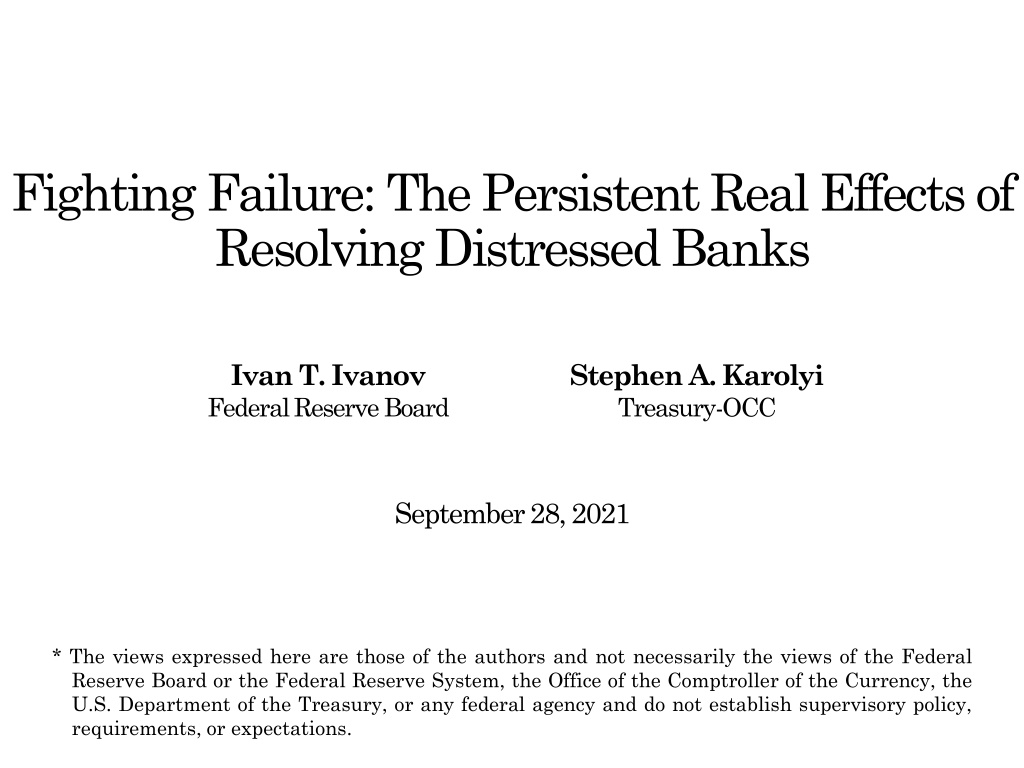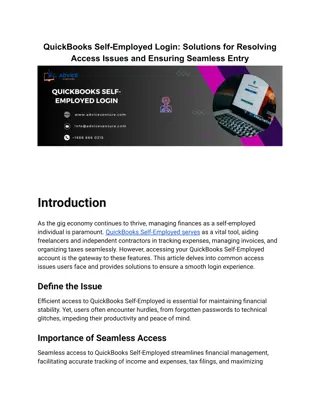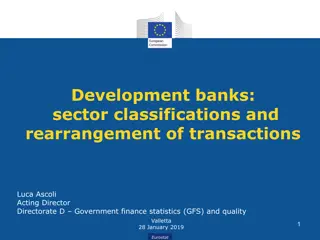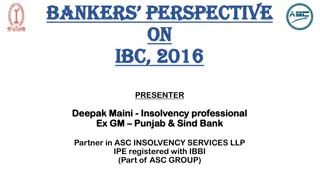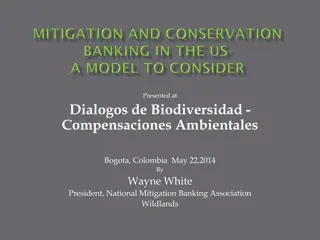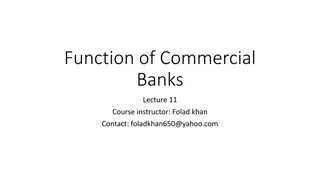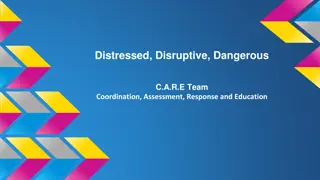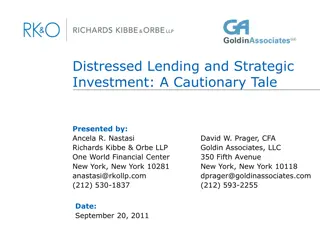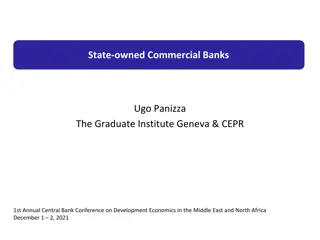Understanding the Real Effects of Resolving Distressed Banks
This study delves into the lasting impact of resolving distressed banks on the economy, showcasing significant compliance with regulatory thresholds and persistent adverse effects on local economies post-resolution. Findings suggest a notable drop in employment and establishments, with effects intensifying up to at least five years post-resolution. The research also highlights the institutional background and typical resolution timeline when dealing with critically undercapitalized banks.
Download Presentation

Please find below an Image/Link to download the presentation.
The content on the website is provided AS IS for your information and personal use only. It may not be sold, licensed, or shared on other websites without obtaining consent from the author. Download presentation by click this link. If you encounter any issues during the download, it is possible that the publisher has removed the file from their server.
E N D
Presentation Transcript
Fighting Failure: The Persistent Real Effects of Resolving Distressed Banks IvanT. Ivanov Federal Reserve Board Stephen A. Karolyi Treasury-OCC September 28, 2021 * The views expressed here are those of the authors and not necessarily the views of the Federal __Reserve Board or the Federal Reserve System, the Office of the Comptroller of the Currency, the __U.S. Department of the Treasury, or any federal agency and do not establish supervisory policy, __requirements, or expectations.
Motivation Banking crises cause persistent and significant output losses (see, Cerra & Saxena, 2008). Greater output losses than wars or currency crises! What are typical regulatory responses to banking crises? Support for the solvent, resolutions for the insolvent Resolutions have played a critical role in the U.S. since the Banking Act of 1933 >3,500 resolutions since the first in 1934
This paper Objective: understand the causal effect of resolutions on the real economy. Empirical challenges: These two populations are very different! Interventions are endogenously targeted at distressed institutions. Potential spillover costs from targeted interventions (e.g., TARP). The FDIC Improvement Act generates quasi-experimental variation in resolution propensity around the 2% tangible equity threshold. Subpopulation of banks we care about resolving the most. We estimate the LATE for distressed banks using RDD around the 2% cutoff.
Preview of findings Significant compliance with the FDICIA threshold: ~53 percentage points jump in resolution propensity at the threshold. Persistent adverse effect on local economies of resolutions: 2% 4% drop in employment and establishments within 3 years. Effects increase until at least 5 years post-resolution. Evidence for a credit channel based on soft information:
Institutional background Prompt corrective action thresholds mandated by FDICIA identify critically undercapitalized banks E.g., tangible equity ratio < 2% Typical resolution timeline: Once 2% is breached, primary regulator sends notice of prompt corrective action to bank managers and the FDIC* The FDIC makes on-site visit to collect financial and operational information, markets the bank to pre-determined set of bidders Compares bids to liquidation costs to the Deposit Insurance Fund Selects least-cost option * Subject to discretion to act or forbear based on capital restoration plan adequacy and the state of the economy
Resolutions over time Discretion to resolve Discretion to forbear
Identification Goal: estimate ATE of resolutions on local economy Approach: fuzzy regression discontinuity Threshold-based resolution policy introduced by FDICIA in 1991 Instrument resolution propensity with critically undercapitalized classification based on 2% tangible equity ratio cutoff Output: LATE estimates of resolutions on local economy for distressed banks Primary caveat concerns external validity
Identification Identifying assumptions: Roberts & Whited `12 Local continuity in the running variable banks cannot precisely manipulate TE
Identification A jump in resolution propensity at the 2% TE ratio cutoff:
Empirical setting Estimate two equation system following recent applied econometrics literature Calonico et al `14, `20; Cattaneo & Vazquez-Bare `16; Gelman & Imbens `19; Imbens & Kalyanaraman `12 First stage: Second stage:
Prompt corrective action Critically undercapitalized banks are more likely to be resolved Dependent Variable: Resolution 1{TE < 2%} (1) (2) (3) (4) (5) (6) 0.559*** (0.053) 0.529*** (0.056) 0.533*** (0.056) 0.535*** (0.060) 0.530*** (0.058) 0.528*** (0.060) N N Left of Cutoff N Right of Cutoff Order Loc. Poly. (p) Bank Controls Local Economy Controls 158,081 447 157,634 1 N N 158,040 446 157,594 1 Y N 158,040 446 157,594 1 Y Y 158,081 447 157,634 2 N N 158,040 446 157,594 2 Y N 158,040 446 157,594 2 Y Y 1st or 2nd degree local polynomials following Gelman & Imbens `19 Triangular kernel and MSE-optimal bandwidth (Imbens & Kalyanaraman `12; Calonico et al `14, `20), controls following Calonico et al `19
Local economic impact Employment growth dynamics
Local economic impact Establishment growth dynamics
Bank lending channel Acquiring institutions that are large and have capacity to absorb hidden losses provide least cost option Resolutions lead to potential absorption of community banks into larger, out-of-market banks Loss of soft information about borrowers of the resolved bank Large banks do not lend to small borrowers Berger & Udell `02; Huber `21 Acquirers ration credit to borrowers of their targets Degryse et al `11
Bank lending channel Effects concentrated in smaller, less urban counties. Horizon (years) Dependent Variable: RD estimate (Small) 1 2 3 4 5 Establishments -0.030** (0.012) (0.015) 0.023 (0.016) (0.025) -0.009 (0.008) 0.008 (0.010) -0.010 -0.083*** (0.023) 0.022 (0.029) -0.116*** (0.031) -0.011 (0.028) RD estimate (Large) 0.034 Dependent Variable: RD estimate (Small) employment -0.064*** (0.022) -0.000 (0.016) -0.017 (0.012) 0.020 (0.012) -0.042*** (0.016) 0.011 (0.014) -0.077** (0.033) 0.000 (0.019) -0.056 (0.036) -0.009 (0.022) RD estimate (Large)
Bank lending channel Does SME lending decline ( Originations/Establishments)? Dependent Variable: SME Lending Horizon (years) RD estimate (All) (1) 1 (2) 2 (3) 3 -0.0010 (0.0009) -0.0042*** (0.0013) 0.0011 (0.0014) -0.0003 (0.0009) -0.0024* (0.0013) 0.0021 (0.0018) -0.0003 (0.0009) -0.0034** (0.0013) 0.0021 (0.0019) RD estimate (Small) RD estimate (Large) N N Left of Cutoff N Right of Cutoff Order Loc. Poly. (p) Bank Controls Local Economy Controls 157,898 444 157,454 2 Y Y 118,404 191 118,213 2 Y Y 39,494 253 39,241 2 Y Y
Concluding remarks We develop a quasi-experimental approach to estimate the effect of failed bank resolutions on economic growth Main findings: Significant adverse effects on employment and establishments Credit supply drops, consistent with a bank lending channel Policy implications: Negative externalities of the least-cost resolution policy Design of resolution process, specifically the use of discretion by primary bank regulators and FDIC
